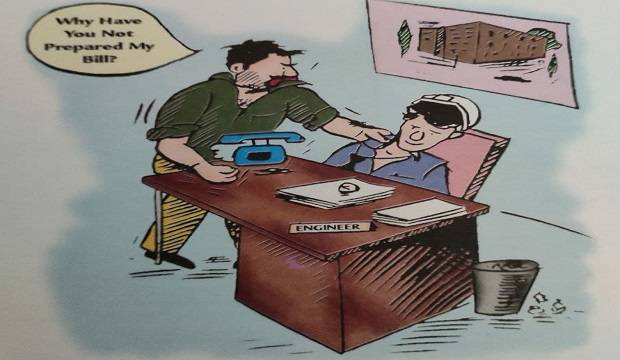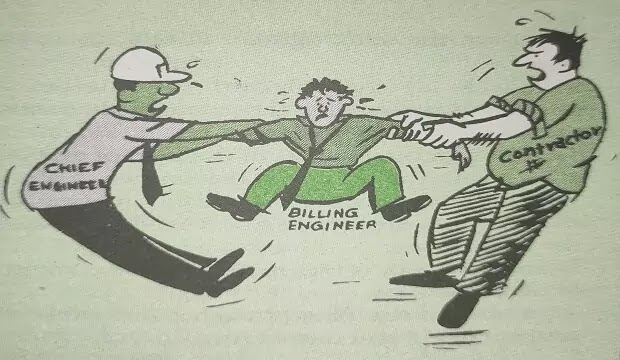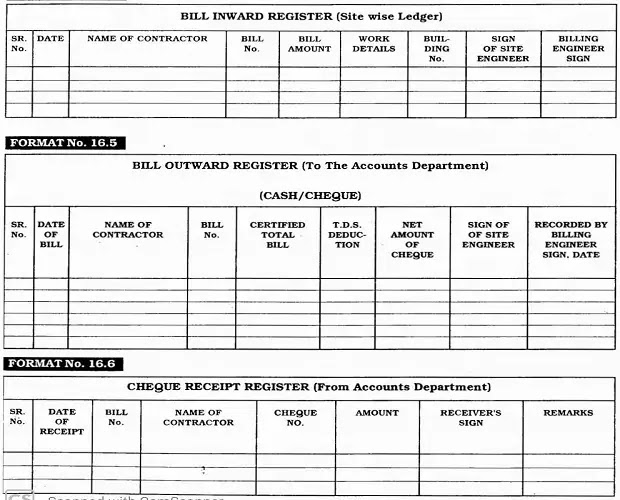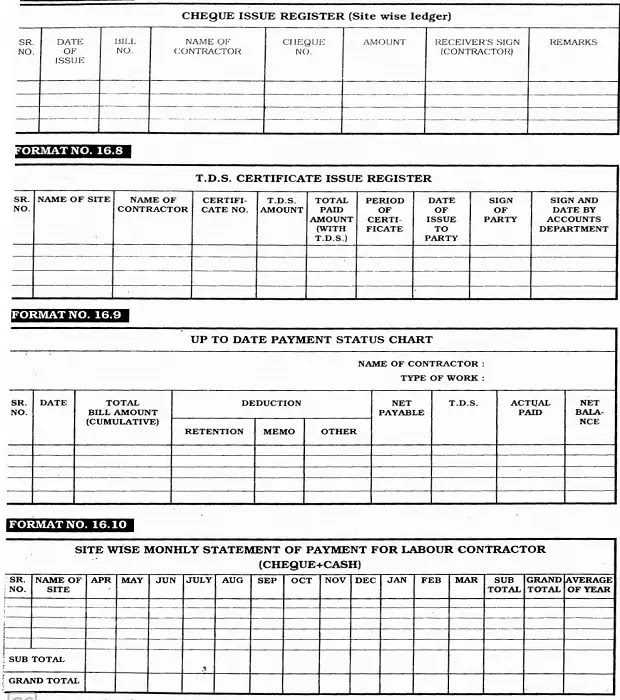Role and responsibilities of billing engineer are the documentary aspects of the work done, through which, payments can be made to the person involved in the contract and who is responsible to complete the work.
Imperfect responsibilities of billing engineer can cause considerable losses to the contractor or the client. Hence, bills should be perfect and self-explanatory, at any stage of the work.
Bills from the work sites are to be prepared on a standard printed format. All information in this format should be correctly incorporated to avoid confusion while checking.
Every organization should maintain certain procedural systems, methods, and norms for preparing bills and forwarding them through the right channels for payments to the contractor.

- For a material contract, the advance bill can be prepared against the material dumped on-site by the contractor.
- The advance bill for the items of work that is expected to be completed within a scheduled period can be forwarded, to avoid delay in payments.
- If bills (submitted from the site) are not clear or the billing engineer wants to cross-check the measurements, quantities and stages of work, then to avoid delay, advance payment against the bill can be prepared.
- Advance billing should be prepared on standard format i.e. payment challan.
- Name of the contractor, name of the site, date, advance note number, previous advance details, etc.
- Agreement of contract.
- Basic rates for material supply.
- Conditions in the contract for the percentage of advance against the supply of material.
- Quality report of material from the site with quantity, approved brand name, challan number, and specimen samples of the received material.
- Name of the contractor, name of the site, date. advance note number, previous advance details, etc.
- Documents required from the site to project the work details, approximate costing of the work to be done, labour strength available at the site, the overall speed of the work, etc.
- The advance bill should be prepared on the payment challan by the site engineer.
- The bills should be forwarded to the accounts department for arithmetical checking, after checking by the role and responsibilities of the billing engineer.
- The cheque, if ready, is forwarded to the engineering department for issuing it to the contractor with proper entries.
“Work status same as previous R.A. bill No.”
DOCUMENTS REQUIRED FOR R.A. BILL
- Agreement of Contracts: Item rate/built-up area basis.
- Quality report of material, from the site, if the contract is with the material.
- Copy of material testing certificate (if any) Name of site, name of the contractor, R.A. bill No., and date.
- Payment challans, abstract, and measurement sheets.
- Samples and brand name of the material used, (if any).
- Figures and sketches with all details.
- Contractor’s sign and Project Engineer’s sign on the bills.
- Contractor’s sign for hidden measurements, such as the quantity of excavation in foundations, etc.
- Refer specimen R.A. bills.
3. CASH BILLS
- “Cash Bill” are required to be prepared for the payments for the following items.
- Weekly payments for the department labourers.
- Petty contractors for small work/job work.
- For urgent work done, on a lump sum basis.
- Any other bills which need to be paid in cash depending on the individual’s requirements.
DOCUMENTS AND INFORMATION REQUIRED FOR CASH BILLS
- Agreement with the contractor, if any.
- Approved rates for various departmental laborers.
- Clarification report for approval of new rates, if any.
- Sketches/ Drawings for the details of work is done.
- Signature of contractor or individual labour on payment challan.
- Payment challan, measurement sheet, abstract, and list of the daily department labour with their names and details of the work done during the period.
- Chief Engineer’s sign for ‘Advance approved’ for weekly cash bill.
- Cash bills to be submitted every week to the billing division.
- The bills should be forwarded to the accounts department at least two days in advance, after checking by the billing division, for making the necessary arrangements for payments.
- The approximate amount may be informed to the accounts department well in advance.
- Payments can be made to the site in-charges, one day prior to weekly payment day, after the checking by the accounts department; so that he can make the payments at the site on time.
4. FINAL BILLS
Final bills should be cleared after 100% completion of the work by the contractor.
Joint measurements should be taken by the engineer, along with the contractor or his representative.
The following point should be considered while preparing the final bill.
- Take reference of measurements from garlic R.A. bills.
- 100% measurements and quality details are required in final bills.
- Repetition of items (if any) should be checked by the engineer.
- Consider the work done by other agencies.
- Write all the details in the bill in a neat and presentable manner.
- Bill measurements should be self-explanatory.
- Start collecting the details for the final bills. well in advance.
LIST OF DOCUMENTS AND INFORMATION REQUIRED FOR FINAL BILL
- Retention…….% for ……..years.
- Photostat/Xerox of the contractor’s quotation with signature, date, and his full address.
- Agreement copy duly signed by contractor and builder.
- Rate copy (if any) other than agreement.
- Built-up area statement (certified).
- Payment status.
- Clarification/inspection report (if any).
- All memo copies.
- Up-to-date payment status from the accounts department.
- Purchase bill signed by the chief accountant, for advance and tax deduction at source (T.D.S.)
- For water-proofing work, ten years guarantee certificate on stamp paper.
- For plumbing, drainage, and waterline three years guarantee certificate on stamp paper.
- For tiling, electrical, painting, carpentry, and road one-year guarantee certificate on stamp paper.
- N.O.C. from maintenance division.
- NO DUES letter from the contractor on his letterhead, at the time of settlement of the final bill, with sign stamp.
- Contractor’s signature on all the copies of bills and measurement sheets.
- A number of sketches to be attached with the following tabular format.
- Payment challan in triplicate to be submitted to the billing division.
- Measurement sheet with detailed measurements and sketches.
- Details of the visit by the role and responsibilities of the billing engineer to a site in tabular format.
TYPES OF CONTRACT AGREEMENTS TO RE CONSIDERED FOR BILLING BUILDING CONSTRUCTION
There are three major types of contracts to be considered Nar billing in building construction.
- Item rate contract
- A built-up area basis contract
- Lump-sum contract
1. ITEM RATE CONTRACT
- In this type of contract, there may be one more contractor. But for billing and or measurement purposes, the work is split into various items.
- The rates are finalized for different items at a certain level which covers the cost of labour, transport, tools, material, plants, etc.
- The additional increase in the rates is for additional lead and lifts.
2. BUILT-UP AREA BASIS CONTRACT
This method has proved to be the easiest method. Hence, it is the most popular method.
IF CONTRACT IS WITH MATERIAL PLUS LABOUR
- For a particular project detailed specification of work is finalized.
- The proposed rate is worked out on the basis of estimated material cost, labour cost and overhead expenses to complete the unit as a finished product.
- The billing is done as (built-up area (in sq,m/s.ft.). of building] x [ agreed rate in rupees/per sq.m s.ft).
- The mode of payment is fixed at various stages of work, as per the percentage agreed in the contract.
- In this method, the work is split into various items. e.g. R.C.C., masonry, tiling, plumbing, etc. These works are entrusted to small but specialized petty contractors on labour rates only.
- The labour rate is arrived at, considering the labour component of the estimated cost, for that particular item.
- The billing and the mode of payment is the same as explained above.
- Normally, petty works are given on a lump sum basis, which includes 100% completion of a particular activity/work in the decided lump sum amount.
- In such contracts, no measurement is required for billing. Only the stage and percentage of the work done can be mentioned for intermediate payments.
PROCEDURE FOR PREPARING BILLS AT BUILDING CONSTRUCTION SITE
1. PROCEDURE OF PREPARING R.A. BILLS
- The following procedure should act as a guideline for preparing R.A. bills on site.
- All bills for the site work should be prepared by the site engineer on the payment challan.
- Information like ‘Name of the Contractor’ as per agreement (Company/Person), building name and number, work details, sanctioned rates, up-to-date work status, payments due should be written.
- All measurements should be recorded on a separate measurement sheet and necessary sketches should also be provided.
- Different types of bills, special instructions, etc. are given in further notes.
- If the bill is prepared on the built-up area basis/ area as per the approved area statement, check the work according to the specifications and percentages due to that particular stage.
- Write all the details on the measurement sheet with sketches to explain the measurements in detail.
- Write the name of the subcontractor on each measurement sheet as well as on the payment challan. The name of the building and type of work should also be written on each page.
- If the bill is on a built-up area basis, clearly mention the built-up area of that particular building.
- If the area is certified by higher authorities, clearly mention the “Certified Built-up area”.
- If the area is subjected to checking and finalization, note it as an “approximate built-up area”. Write down the total bill amount on each bill i.e. [built-up areal x lappróved rate/sq.m/s.ft]= total bill amount.
- The payment should be made as per the stages of work and the percentage of the payment, payable up to that stage of the work. Previous work is done and advances paid up to date should be considered, before arriving at the final figure.
- If the bill is based on an item rate basis, note down the estimated quantity of each item in the first bill, with the essential sketches.
- The rates should be as per the agreement.
- Before preparing any bill, confirm the approved rates from the billing division to avoid delays in clearing the bills.
- Write down the up-to-date amount paid on each bill, In addition to the new bill payment, to derive the total bill amount for that respective bill.
- It Is essential to know the advance amount to be paid to the subcontractor, for verification of the bill.
- The signature of the contractor on the bill is a must. If the is not available, then the reason why his signature was not taken should be mentioned clearly on the bill.
- If the up-to-date amount paid is less then the total bill amount (including retention) only then the bill is valid for payment.
- The bill, after scrutiny from the engineering division, is put up before the Chief Engineer, He decides the quantum of payment to be made against the particular bill.
- Running bills are advised to be prepared strictly on the first and the sixteenth day of each month.
2. PROCEDURE FOR PREPARING DEPARTMENT LABOUR BILLS.
- These should be submitted on any fixed weekdays and a recording of the previous week should be considered for payments. They should be submitted in triplicate copies as per the following steps
- Write down the name of the site, date, bill number. name of the subcontractor on each measurement sheet and payment challan.
- Labour includes male coolies, female coolies, masons, carpenters, plumbers, helpers, fitters, etc. employed for various departmental labour work. A list of names of each individual labour and payment due is to be given, along with the individual’s signature.
- The sign of supervisor, site engineer, and P.E. is a must on all copies.
- The following points should be considered while preparing cash bills – If the bill is prepared against any work order. A copy of the work order should be attached. If available at the site office.
- If the rates are different than the regular sanctioned rates, write down the clarification report number/any other document which indicate that the rates are sanctioned or P.E approved.
- Write the previous up-to-date bill payment in the appropriate column.
- The subcontractor or individual labourers should sign the payment challan.
- Write ‘Pay by Cash’ remark on the payment challan clearly on the bill.
- The sign of the J.E., P.E., C.E., is a must on every copy of the payment challan.
4. PROCEDURE FOR PREPARING FINAL BILLS
Refer serial number 16.2(4) for the final bill procedure for a list of the documents and information required for the final bill.
- Write down the name of the subcontractor on each page, date, bill number, work is done, name of the building on the bill.
- If the bill is of the ‘built-up area’ type, it is essential to use the certified built-up area for the calculations.
- The certified built-up area should be accompanied by the essential sketches, showing all dimensions and detailed calculations.
- A photostat/Xerox of the main terms and mode of measurement in the agreement is also required for the final bill.
- The certified built-up area should be agreed upon and counter-signed by the subcontractor.
- When 100% of work is completed by the subcontractor, N.O.C. from the P.E. is required, to release the final payment.
- Memo N.O.C. is also required from the P.E. It is essential to take the subcontractor’s signature on each memo.
- P.E./S.E. should check the actual quantity of each item and rate for the item rate type and built-up type of bill.
- If any extra work, apart from that mentioned in the agreement, is carried out on the site, it should be clearly mentioned in the final bill.
- When the checking is over, a purchase bill should be prepared and should be sent to the accounts department for coding. This can be done in the engineering division.
- After coding, the payment challan, along with the measurement sheet and the purchase, the bill should be sent to the accounts department for checking advance payment.
- The advance should be checked, verified, and countersigned by the accountant.
- The bill should then be checked and signed by C.E.
- Before re-submitting the final bill to the accounts department, the subcontractor should sign on the three copies of the purchase bill, along with his stamp.
- A cheque for the final bill amount should be issued to the subcontractor, after getting the ‘No Dues’ certificate from him on his letterhead.
- If for any reason, some part of the work in the scope of the contractor is carried out by some other agency, the amount paid to that agency should be deducted from the contractor’s R.A. bills.
CHECKING OF BILLS BUILDING CONSTRUCTION SITE
IMPORTANT POINTS TO BE OBSERVED
Check the following before actual checking
- Name of site, date, bill number
- Name of the contractor
- Signature of engineer and contractor
- Attached statement, figures, N.O.C. samples
- The page number on the measurement sheet
Actual bill checking
- Calculating of quantities
- Norms for calculations
- Cross-checking with drawings available
- Details are given in sketch and calculations
- Changes in drawings as per site condition
- Mode of measurement
- Quantities as per the conditions of the agreement
- Cross-checking as per site visit by billing engineer
- The difference in the earlier R.A. bill and the present R.A. bill for the same quantities
- Any supporting documents for changes Rate as in norms, conditions of agreements, etc.
- Rate as per agreement
- Changes in the rate
- Calculation of amount
- All deductions
PROCEDURE OF PAYMENTS AGAINST BILLING
- The following procedure should be followed for payment against the bill.
- Checking the bill’ in duplicate by the role and responsibilities of billing engineer, with necessary deductions and certifying for payments (certified amount should be written).
- Forward to the Chief Engineer for checking and signature.
- Forward to the accounts department for necessary checking and preparing the cheques.
- The accounts department should send the original copy of the payment challan to the billing section after necessary entries in their record.
- The accounts department should send the cheques, along with the duplicate copy of the payment challan to the engineering division.
- The site in-charge will give written confirmation to the C.E. with the contractor on the payment day for payment, considering the speed of work, scheduled work, labour strength, due amount, etc.
- The engineering division will issue cheques to the contractor through the receptionist or the role and responsibilities of the billing engineer with proper entries and signature of the contractor, after confirmation from the site in-charge.
- The mode of payment again depends on the agreement.
- Normally, the following frequency for payment can be maintained.
- For cash bills department bills once a week.
- Running account bills for routine work once a fortnight.
- Final bills within three months after submission of the final bills.
- Apart from this, urgent payments can be made as per the requirements/situations.
Billing is one of the most important documentary activities in building construction work, The role and responsibilities of the billing engineer should be perfect in his work since the work involves a lot of calculations, field knowledge of the work and awareness of other norms of billing.
Some important duties and responsibilities of the billing engineer can be listed as below.
- To see that all the bills from the site are on time, If delayed, issue a reminder.
- To see that every bill is entered in the bill inward registers by the site in-charge.
- To check the bill on time.
- To check the bills as per priority and forward it to higher authoríties for approval on the schedule To inform the site engineer about any missing data.
- To check all the relevant information and documents required for the payment challan, with the bills.
- To maintain the records of the receipt and issue of bills with the accounts department.
- To maintain records of the cheques received from the accounts department and cheques issued to the contractors.
- To issue a copy of bills to the site after completion of all formalities.
- To maintain the files of each contractor, with proper coding and numbering.
- To update the contractor’s file and payment status.
- To inform the payment status of every contractor to the higher authorities site, as and when required.
- To find out mistakes, if any, in the bill and bring them to the notice of the Chief Engineer.
- Inform the site about it.
- Make deductions, as applicable from the bills.
- To update the information of the prevailing Government rules about the tax deduction and other norms of payment billing.
- To update the information of the mode of measurement for all construction activities, rules for billing, and other standard methods of calculations.
- To explain the status of work and payment to the contractor.
- To settle the bills/final bills with the contractor. including the total bills and deductions.
- To prepare statements and records daily/monthly/when required.
- To study all the agreements of contractors, in detail.
- To prepare the statements requiréd by the accounts department as and when required.
- To discuss the problems of billing with the concerned persons with resulting documents.
- To prepare the required data for the auditor.
- The following recording should be done by the billing engineer, for various transactions of the records from department to department. Updating of records should every day.
- Refer to the formats are given below as a guideline to maintain records in a better way.
3. BILLS OUTWARD REGISTER (To accounts department)
4. CHEQUE RECEIPT REGISTER (From accounts department)
5. CHEQUE ISSUE REGISTER (Site wise Ledger)
6. T.D.S. CERTIFICATE ISSUE REGISTER
7. MEMO STATEMENT
8. UP-TO-DATE PAYMENT STATUS CHART
 |
Also, Read This.


